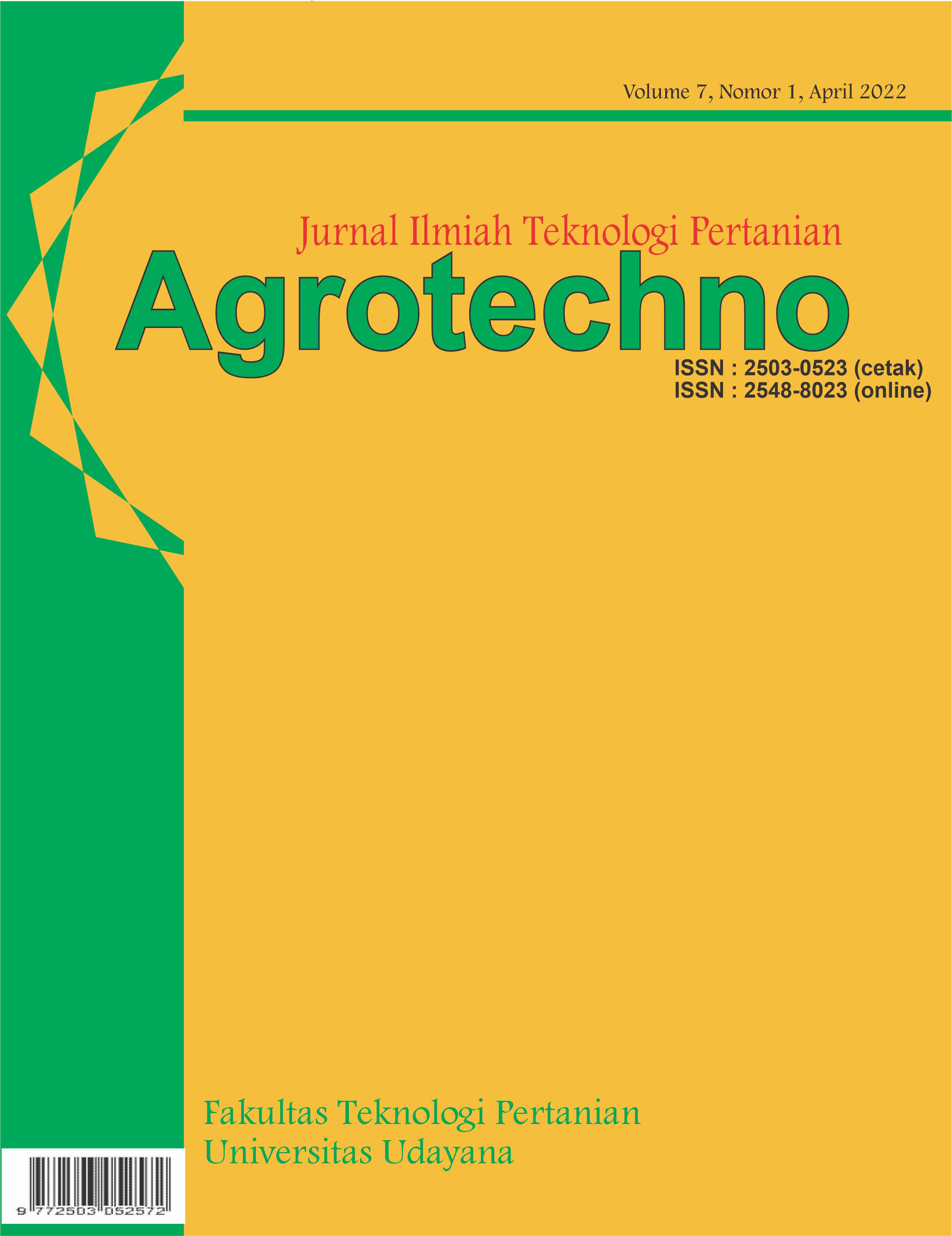Optimasi Suhu dan Waktu Proses Delignifikasi pada Isolasi Selulosa dari Tongkol Jagung
Abstract
This study aims to optimize the temperature and time of the delignification process to isolate cellulose from corn cobs. The research was carried out in stages, namely preparing corn cob powder samples and the delignification process. Statistical regression modeling and optimization of the temperature and time of the delignification process used the response surface (RSM) methodology. Central Composite Design (CCD) was used for experimental design and analysis of the effect of temperature and time of the delignification process on lignin, cellulose, hemicellulose, and fiber yields. The optimum process conditions were determined using the desirability method. The analysis of the diversity of the quadratic polynomial model shows that the temperature and time of the deligninification process significantly affect changes in the characteristics of lignin, cellulose, hemicellulose, and fiber yields. The optimal condition of the corncob fiber delignification process was obtained at a temperature of 100.38? for 79.17 minutes. It produced the characteristics of delignified fiber with lignin, cellulose, hemicellulose, and yields of 6.47%, 73.73%, 5, respectively. 39% and 57.76% w/w. The optimization model is valid with a desirability value of 0.71. Thus, the temperature and time optimization model of the delignification process can be applied in real conditions to produce delignified corncob fiber with optimum characteristics.
Downloads
References
Akram, T., Abbas, M., Riaz, M. B., Ismail, A. I., & Ali, N. M. (2020). An efficient numerical technique for solving time fractional Burgers equation. Alexandria Engineering Journal, 59(4), 2201–2220. Retrieved from https://doi.org/10.1016/j.aej.2020.01.048
Amdoun, R., Khelifi, L., Khelifi-Slaoui, M., Amroune, S., Asch, M., Assaf-ducrocq, C., & Gontier, E. (2018). The Desirability Optimization Methodology; a Tool to Predict Two Antagonist Responses in Biotechnological Systems: Case of Biomass Growth and Hyoscyamine Content in Elicited Datura starmonium Hairy Roots. Iranian Journal of Biotechnology, 16(1), 11–19. Retrieved from https://doi.org/10.21859/ijb.1339
Arnata, I. W., Suprihatin, S., Fahma, F., Richana, N., & Candra Sunarti, T. (2019). Cellulose Production from Sago Frond with Alkaline Delignification and Bleaching on Various Types of Bleach Agents. Oriental Journal of Chemistry, 35(Special Issue 1), 08–19. Retrieved from https://doi.org/10.13005/ojc/35specialissue102
Asghar, U., Irfan, M., Iram, M., Huma, Z., Nelofer, R., Nadeem, M., & Syed, Q. (2015). Effect of alkaline pretreatment on delignification of wheat straw. Natural Product Research, 29(2), 125–131. Retrieved from https://doi.org/10.1080/14786419.2014.964712
Dewi, R. K., Zuhroh, S. T., & Zulaikha, S. (2018). Delignification of chandlenut shell waste with alkali pretreatment method as an alternative fuel feedstock. International Journal of Mechanical Engineering and Technology, 9(10), 271–278.
Dutta, S. K., Halder, G., & Mandal, M. K. (2014). Modeling and optimization of bi-directional delignification of rice straw for production of bio-fuel feedstock using central composite design approach. Energy, 71, 579–587. Retrieved from https://doi.org/10.1016/j.energy.2014.04.108
Fukushima, Y., Takahashi, Y., Hori, Y., Kishimoto, Y., Shiga, K., Tanaka, Y., … Kondo, K. (2015). Skin photoprotection and consumption of coffee and polyphenols in healthy middle-aged Japanese females. International Journal of Dermatology, 54(4), 410–418. Retrieved from https://doi.org/10.1111/ijd.12399
Hii, K. L., & Mashitah, M. D. (2014). Optimisation of pressed pericarp fibre delignification for glucose recovery using response surface methodology. International Journal of Environmental Engineering, 6(2), 220. Retrieved from https://doi.org/10.1504/ijee.2014.062157
Huang, R. L., Qi, W., Su, R. X., & He, Z. M. (2010). The optimization of fractionating lignocellulose by formic acid using response surface methodology. Energy Sources, Part A: Recovery, Utilization and Environmental Effects, 32(14), 1282–1292. Retrieved from https://doi.org/10.1080/15567030903076669
Kardiman Silaban, Chairul, & Sembiring, M. P. (2015). Penentuan Suhu dan Waktu Optimum pada Tahap D0 (Delignifikasi Pertama) Proses Bleaching Pembuatan Pulp. Jurnal Online Mahasiswa (JOM) Bidang Teknik Dan Sains, 2(2), 1–7. Retrieved from https://doi.org/10.16285/j.rsm.2007.10.006
Karim, M. Z., Chowdhury, Z. Z., Hamid, S. B. A., & Ali, M. E. (2014). Statistical optimization for acid hydrolysis of microcrystalline cellulose and its physiochemical characterization by using metal ion catalyst. Materials, 7(10), 6982–6999. Retrieved from https://doi.org/10.3390/ma7106982
Khalid, N., Abbas, M., Iqbal, M. K., Singh, J., & Ahmad, A. I. (2020). A computational approach for solving time fractional differential equation via spline functions. Alexandria Engineering Journal, 59(5), 3061–3078. Retrieved from https://doi.org/10.1016/j.aej.2020.06.007
Kundu, C., Samudrala, S. P., Kibria, M. A., & Bhattacharya, S. (2021). One-step peracetic acid pretreatment of hardwood and softwood biomass for platform chemicals production. Scientific Reports, 11(1), 1–11. Retrieved from https://doi.org/10.1038/s41598-021-90667-9
Mukherjee, A., Banerjee, S., & Halder, G. (2018). Parametric optimization of delignification of rice straw through central composite design approach towards application in grafting. Journal of Advanced Research, 14, 11–23. Retrieved from https://doi.org/10.1016/j.jare.2018.05.004
Oliveira, L. R. M., Nascimento, V. M., Lee S. Corso, D., Silva, V. F. N., Rocha, G. J. M., & Gonçalves, A. R. (2013). Effects of alkaline organosolv delignification on enzymatic conversion of cellulose from sugarcane bagasse pretreated by steam explosion. Revista Investigaciones Aplicadas, 7(1), 1–10.
Sahare, P., Singh, R., Laxman, R. S., & Rao, M. (2012). Effect of Alkali Pretreatment on the Structural Properties and Enzymatic Hydrolysis of Corn Cob. Applied Biochemistry and Biotechnology, 168(7), 1806–1819. Retrieved from https://doi.org/10.1007/s12010-012-9898-y
Sampora, Y., Devy, Y. A., Sondari, D., & Septevani, A. A. (2020). Simultaneous Pretreatment Process on The Isolation of Cellulose Mycrocrystalline from Oil Palm empty Fruit Bunches. Reaktor, 20(4), 174–182. Retrieved from https://doi.org/10.14710/reaktor.20.4.174-182
Sebran, N. H., Gaik, L. P., & Hussain, A. S. (2018). Structural Analysis on the Effect of Base-Catalysed Delignification Process Parameters on Palm Oil Empty Fruit Bunches Fibres using Glycome Profiling. IOP Conference Series: Materials Science and Engineering, 458(1). Retrieved from https://doi.org/10.1088/1757-899X/458/1/012070
Stoica, I., Petrovici, A. R., Silion, M., Varganici, C. D., Dinica, R., & Bahrim, G. (2018). Corn cob hydrolyzates used for microbial biosynthesis of polyhydroxybutyrate. Cellulose Chemistry and Technology, 52(1–2), 65–74.
Wang, H., Cui, X., Wang, R., & Li, C. (2012). Response surface optimization of the operating parameters for a complex distillation column based on process simulation. Energy Procedia, 16, 571–578. Retrieved from https://doi.org/10.1016/j.egypro.2012.01.092
Zawawi, A. Z., Gaik, L. P., Sebran, N. H., Othman, J., & Hussain, A. S. (2018). An optimisation study on biomass delignification process using alkaline wash. Biomass Conversion and Biorefinery, 8(1), 59–68. Retrieved from https://doi.org/10.1007/s13399-017-0246-x
Zhang, B., Abolghasem, S., Wang, L., Diallo, O., & Allante, W. (2010). Alkali Pretreatment and Enzymatic Hydrolysis of Cattails from Constructed Wetlands Bo Zhang , Abolghasem Shahbazi , Lijun Wang , Oumou Diallo and Allante Whitmore Department of Natural Resources and Environmental Design ,. American Journal of Engineering and Applied Sciences, 3(2), 328–332.
Zinovyev, G. (2015). The influence of delignification methods on the overall yield and quality of cellulose : a review, 1–25.










